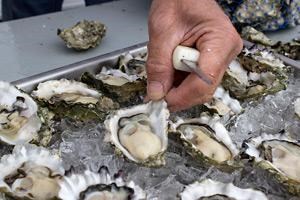Editor's Note: Since publishing this story in the Peak, August 19, Canadian Food Inspection Agency has now extended the ban on raw oysters Canada-wide.
Restaurants and shellfish lovers are being advised to cook all BC oysters prior to serving them at this time, according to a media release issued by Vancouver Coastal Health (VCH) on August 12.
“This action is in addition to the ongoing public health warning in VCH restaurants about the increased risk of gastrointestinal illness associated with the consumption of all raw oysters,” read the statement.
Unusually warm temperatures this summer have resulted in higher concentrations of the Vibrio parahaemolyticus bacteria in waters along much of the BC coastline. The organism is naturally occurring and is different from red tide (paralytic shellfish poisoning), as it is not caused by an algal bloom. It also does not pose any significant risk to swimmers.
While most instances of food-borne illness go unreported, VCH has been made aware of at least 31 cases so far this year. That number is up significantly from August 2014, when only 16 were known.
“The overwhelming majority of people who have gotten ill have gotten ill from consuming raw oysters harvested in British Columbia,” explained Dr. Reka Gustafson, a medical health officer with VCH. “Given that our responsibilities are to protect the health of the public, this was the intervention that’s available to us — to respond to an outbreak that we are detecting.”
Symptoms of Vibrio parahaemolyticus infection may include watery diarrhea, vomiting, fever and malaise, all of which can last up to a week. Gustafson confirmed that at least one of the recent cases did occur in Powell River. “Not local residents, but people who have travelled there,” she said. It is unknown whether the oysters they consumed were self-harvested or eaten at a restaurant.
Food establishments take these kinds of warnings very seriously, said Chef David Bowes, owner of the Laughing Oyster in Okeover Arm, although it is unprecedented to see them issued by VCH.
“Usually, it comes down through fisheries if they have product that needs to be recalled and that needs to be recalled to the point that there’s a cook advisory on it,” he said. “I would usually be getting that information through my suppliers.”
When he phoned his suppliers last week to enquire further, Bowes was told their oysters were still being deemed safe by federal fisheries. However, diners won’t be seeing raw ones on Laughing Oyster’s menu for a while. “There’s no way,” he said. “When the health board says don’t serve it, we don’t serve it.”
For local shellfish farmers like Yves Perreault of Little Wing Oysters, the latest warning comes with a sizable financial impact. “This advisory is going to mean a significant loss of business for quite a few guys,” he said.
As president of the BC Shellfish Growers’ Association, Perreault has a perspective on the industry that runs far deeper than his oyster beds. “I think we’re going to be having a lot of discussion with CFIA [Canadian Food Inspection Agency] in particular around how we can best manage this, because obviously it’s not working,” he said.
According to Perreault, a better testing model is needed to ensure shipments don’t get caught in the middle. With so much variability from site to site and significant delays in getting test results back from the lab, the best solution at VCH’s disposal remains a full ban on raw oysters when numbers spike as they have, “even though some types might be good.”
Because the bacteria thrives in warmer water, some farms are more susceptible than others due to their location.
Such has been the challenge for Okeover Organic Oysters, operated by Chris Roberts and André Comeau. “At this point in our year, we close ourselves,” said Roberts. “Basically, every August we take off because we’re at the south end of Okeover. It’s shallow, it’s warm, our water can be 26 degrees for weeks on end. Vibrio is alive at 10 degrees. It’s growing at 15. At 20 it’s doubling in some insane amount of time, so we close ourselves. Yves, because of his situation, he’s further out the inlet, he’s in really deep, fast-flowing water. He tests clean year-round.”
“We definitely have to figure out how to get through a summer season like this without getting so many illnesses,” said Perreault, speaking for the industry as a whole. “We don’t really like that, so we just have to work on a better system to make sure that it’s not going to happen again.”
Cooking oysters
Suggested cooking times for oysters, courtesy of Dr. Reka Gustafson, medial health officer with Vancouver Coastal Health.
BOILING
Add to boiling water, cook for three to five minutes after shells are open.
STEAMING
Steam for four to nine minutes. Throw out any shellfish with unopened shells.
FRYING
Fry for at least three minutes at 375 degrees fahrenheit.
BAKING
Bake for at least 10 minutes at 450 degrees fahrenheit.



